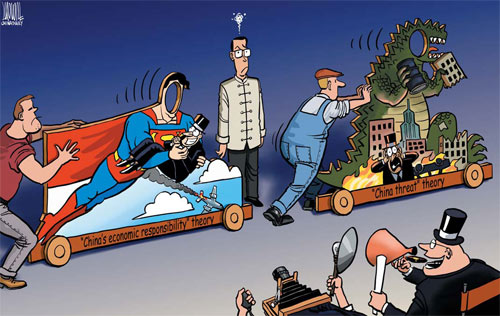Photos
Seizing on growing common interests
Updated: 2011-04-01 10:23
By Zheng Bijian (China Daily European Weekly)
|
 |
On the subject of fostering "convergence of interests" and building "communities of interests", I must first speak briefly about the ideas and goals of China's development in the second decade of the 21st century.
The first two decades of the 21st century are a crucial period in China's endeavor to "build a moderately prosperous society at a higher level benefiting more than one billion people". It is a period of development focusing on improving the lives of the people and raising the quality of life in a sustainable manner. It is also a period of transformation of China's economy from quantitative growth to qualitative lifting. Now half of this relatively independent historical period has passed. On the whole, we have done quite well in quantitative terms, but not so satisfactorily in qualitative terms.
In the second decade of the 21st century, China's development faces a number of challenges: resources and environment constraints on economic growth; unbalanced economic and social development including imbalances between investment and consumption; between the city and the rural areas and between the eastern and western regions; and industrial and research and development restructuring. There are also problems with human resources unable to meet the needs of the nation's employment structure; with the inequitable distribution of incomes; with lagging social governance and increasing social conflicts; and with severe natural disasters.
To meet these challenges, our work in the second decade of the 21st century will concentrate on pushing forward on transforming our economy; ensuring and improving people's livelihood; consolidating and expanding achievements made in response to the international financial crisis; and facilitating long-term, steady and reasonably fast economic growth and achieving harmony and stability in the country. All this will lay a solid foundation for building a prosperous society.
To this end, we must transform our economy from one mainly driven by external demand to one driven by both domestic and external demands, mainly domestic demand. This will be accompanied by accelerated changes in society and how people spend money. China, a lower middle-income country, will move to an upper middle-income country at a faster pace. What is more, China will devote more efforts to realizing domestic development, to raising ethical standards and inspiring people to work for ideals. Thus China will achieve the goal of peaceful rise and cultural renaissance. Without a doubt, a China that follows this path will provide the rest of the world with a bigger market and a greater opportunity for development.
China's path of its peaceful rise accords with historical trends. Today the world is developing in a manner conducive to globalization and interdependent international relations. In this context, dialogue, consultations, coordination, proper management and reform in a peaceful, cooperative and mutually beneficial manner will be the means to tackle existing and emerging problems. This is the main trend of mankind's future development. The world as a whole will face both opportunities and challenges with the former outnumbering the latter.
Given the fact that, in the first decade of the 21st century, China's peaceful development has made it an important part for world development, and a sound foundation of common interests has been built between China and the United States - with pragmatism and political wisdom of both sides - China will continue in the second decade to follow this development path and thus become a more important part of the world development. And in the same manner as in the first decade, China and the US may develop common interests that are better defined and more sustainable.
All this will determine the direction of China's relations with the world and with the US in the next decade and beyond.
In the second decade, China's path of peaceful rise and policy of "building a harmonious world" need to be solidified. The important thing is "to expand and deepen the convergence of interests of all parties", and foster "communities of interests" with other countries and regions in different areas and at various levels. This is the policy China has adopted for this decade. This is what we must do to meet the needs not only of China's own development, but also the common development of countries. And I believe it also conforms to how the world is developing. We hope that more and more countries will recognize and understand our policy choice.
"To expand and deepen convergence of interests" and "to build communities of interests" have become the policy of the Chinese government. In particular, "to expand and deepen the convergence of interests with various parties" has been incorporated into the Communist Party of China Central Committee's Proposal on Formulating the 12th Five-Year Plan for Economic and Social Development. In an address to the opening ceremony of the 8th ASEM (Asia-Europe Meeting) Summit, Premier Wen Jiabao proposed that ASEM members should become a "close-knit community of interests". President Hu Jintao, in his telephone conversation with US President Barack Obama, said further: "We face an important subject, i.e. how to actively elevate the positive, cooperative and comprehensive China-US relationship to a higher level and enter into a cooperative partnership in areas of common interests."
I would say that in fact the convergence of interests between China and the US already exists. Let us recall briefly what happened in the past few years. Since 2008, our two countries joined hands to cope with the impact of the financial crisis. It was a most significant convergence of interests under the special conditions of that time. Now, we need to adapt to each other and make the necessary adjustments in order to work together to deal with changes post-financial crisis and handle the domestic restructuring of each country. This may become a new convergence of interests between our two countries. In this regard, one thing is worth our attention: The Chinese and American economies are mutually complementary and interdependent in trade, and now they are increasingly complementary in investment as well. Just as John Thornton has proposed, Chinese investments in American infrastructure projects and medium and small enterprises in America's South and West will help with its economic recovery and increase jobs. I think this will show that China-US common interests are moving from the strategic macro level to a micro level.
Apart from our dialogue on China-US relations, we shall also explore ways to converge interests and build communities of interests between our two countries in certain important areas of clean energy. I believe this kind of discussion will not only contribute to global efforts to address the challenge of climate change, but also help develop low-carbon industries and energy security for our respective countries. In addition, it may create more business opportunities for our two countries. China-US cooperation in clean energy surely can expand and deepen the convergence of interests and become an important part of the "communities of interests" that we are building.
In short, as we have pulled together during the international financial crisis, and now are in the process of economic restructuring and cooperation in climate change and clean energy, we find more converging interests between our two countries and better conditions for building "communities of interests" in different areas and at various levels.
Even on sensitive issues, China is encouraged by the overall interest of our bilateral relations and has given priority to a stable relationship. It has tried to expand the convergence of interests with other parties based on mutual respect for each other's core interest and major concerns. For instance, on the issue of the Korean Peninsula, we have stated in explicit terms our opposition to provocative acts by any side that may lead to tension and any attempt to develop nuclear weapons on the Peninsula. On the question of Taiwan, we have adopted the policy of "reconciliation, peace and harmony" and made efforts to advance the common interests of the people on both sides of the Taiwan Straits. On military modernization, we have adhered to a policy of defense and rejected military expansion. On the issue of maritime security, we have intensified cooperation with countries in a joint effort to preserve international shipping safety.
Looking down the road, the next 10 years will witness peaceful and gradual transformation of global governance and the international division of labor. This will again present strategic opportunities for China and the US. In the process of world economic and political changes, the basic factors and driving forces that pushed forward China-US, China-Europe and China-Japan relations in the past 10 years still exist, despite our problems and differences with those countries. This requires us to seek new growth points in both bilateral and multilateral relations with a view to expanding and deepening our convergence of interests and building "communities of interests", which will be beneficial to all parties.
In short, it is both necessary and possible for us to work together with a global vision, pragmatic spirit and political wisdom to build bilateral and multilateral communities of interests in different areas and at different levels in the second decade of this century. To achieve this goal, one must transcend the differences in ideology and social systems, and discard the parochial attitude of closing the door to others. When there is an accumulation of converging interests, there will be a solid foundation of common interests. Then the conditions will become ripe for building communities of common interests.
The author is former executive vice-president of the Party School of the CPC Central Committee.
Specials

Fill dad's shoes
Daughter and son are beginning to take over the family business of making shoes.

Have you any wool?
The new stars of Chinese animation are edging out old childhood icons like Mickey Mouse and Hello Kitty.

Virtual memorial
High-Tech touches to traditional tombsweeping festival help environment